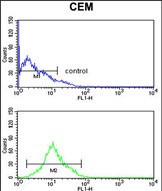KCNJ11 Antibody (N-term)
Affinity Purified Rabbit Polyclonal Antibody (Pab)
- 产品详情
- 实验流程
- 背景知识
Application
| WB, FC, E |
|---|---|
| Primary Accession | Q14654 |
| Other Accession | O02822, Q61743 |
| Reactivity | Human, Mouse |
| Predicted | Rabbit |
| Host | Rabbit |
| Clonality | Polyclonal |
| Isotype | Rabbit IgG |
| Calculated MW | 43526 Da |
| Antigen Region | 1-30 aa |
| Gene ID | 3767 |
|---|---|
| Other Names | ATP-sensitive inward rectifier potassium channel 11, IKATP, Inward rectifier K(+) channel Kir62, Potassium channel, inwardly rectifying subfamily J member 11, KCNJ11 |
| Target/Specificity | This KCNJ11 antibody is generated from rabbits immunized with a KLH conjugated synthetic peptide between 1-30 amino acids from the N-terminal region of human KCNJ11. |
| Dilution | WB~~1:1000 FC~~1:10~50 E~~Use at an assay dependent concentration. |
| Format | Purified polyclonal antibody supplied in PBS with 0.09% (W/V) sodium azide. This antibody is purified through a protein A column, followed by peptide affinity purification. |
| Storage | Maintain refrigerated at 2-8°C for up to 2 weeks. For long term storage store at -20°C in small aliquots to prevent freeze-thaw cycles. |
| Precautions | KCNJ11 Antibody (N-term) is for research use only and not for use in diagnostic or therapeutic procedures. |
| Name | KCNJ11 |
|---|---|
| Function | Inward rectifier potassium channel that forms the pore of ATP-sensitive potassium channels (KATP), regulating potassium permeability as a function of cytoplasmic ATP and ADP concentrations in many different cells (PubMed:29286281, PubMed:34815345). Inward rectifier potassium channels are characterized by a greater tendency to allow potassium to flow into the cell rather than out of it. Their voltage dependence is regulated by the concentration of extracellular potassium; as external potassium is raised, the voltage range of the channel opening shifts to more positive voltages. The inward rectification is mainly due to the blockage of outward current by internal magnesium. Can be blocked by extracellular barium (By similarity). In pancreatic cells, it forms KATP channels with ABCC8/SUR1 (PubMed:29286281, PubMed:34815345). Can form cardiac and smooth muscle-type KATP channels with ABCC9. |
| Cellular Location | Membrane; Multi-pass membrane protein. |
For Research Use Only. Not For Use In Diagnostic Procedures.
Provided below are standard protocols that you may find useful for product applications.
BACKGROUND
ATP-sensitive potassium (K(ATP)) channels are found in endocrine cells, neurons and both smooth and striated muscle, where they play an important role in controlling insulin secretion and vascular tone, and protect neurons under metabolic stress. Kir6.2 is a member of the inward rectifier potassium channel family, which is characterised by a greater tendency to allow potassium flow into the cell rather than out of it. It associates with the sulphonylurea receptor SUR1/ABCC8 to form a subfamily of K(ATP) channels that, when mutated or misregulated, are associated with forms of hyperinsulinemic hypoglycemia, neonatal diabetes, or pre-disposition to type 2 diabetes mellitus.
终于等到您。ABCEPTA(百远生物)抗体产品。
点击下方“我要评价 ”按钮提交您的反馈信息,您的反馈和评价是我们最宝贵的财富之一,
我们将在1-3个工作日内处理您的反馈信息。
如有疑问,联系:0512-88856768 tech-china@abcepta.com.























 癌症的基本特征包括细胞增殖、血管生成、迁移、凋亡逃避机制和细胞永生等。找到癌症发生过程中这些通路的关键标记物和对应的抗体用于检测至关重要。
癌症的基本特征包括细胞增殖、血管生成、迁移、凋亡逃避机制和细胞永生等。找到癌症发生过程中这些通路的关键标记物和对应的抗体用于检测至关重要。 为您推荐一个泛素化位点预测神器——泛素化分析工具,可以为您的蛋白的泛素化位点作出预测和评分。
为您推荐一个泛素化位点预测神器——泛素化分析工具,可以为您的蛋白的泛素化位点作出预测和评分。 细胞自噬受体图形绘图工具为你的蛋白的细胞受体结合位点作出预测和评分,识别结合到自噬通路中的蛋白是非常重要的,便于让我们理解自噬在正常生理、病理过程中的作用,如发育、细胞分化、神经退化性疾病、压力条件下、感染和癌症。
细胞自噬受体图形绘图工具为你的蛋白的细胞受体结合位点作出预测和评分,识别结合到自噬通路中的蛋白是非常重要的,便于让我们理解自噬在正常生理、病理过程中的作用,如发育、细胞分化、神经退化性疾病、压力条件下、感染和癌症。







